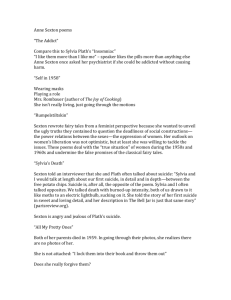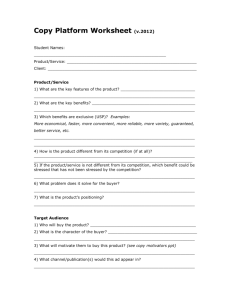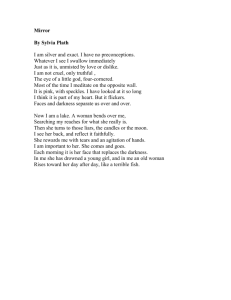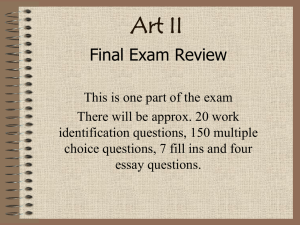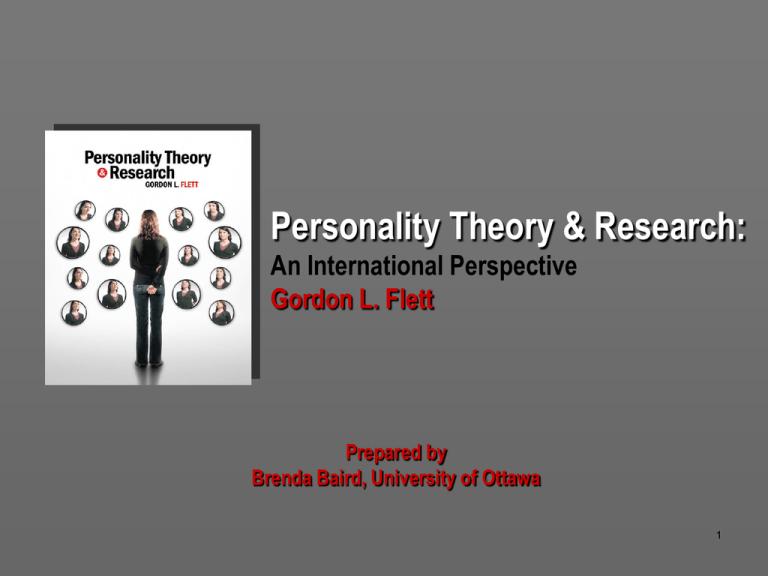
Personality Theory & Research:
An International Perspective
Gordon L. Flett
Prepared by
Brenda Baird, University of Ottawa
1
Chapter 14 Overview
• What Psychobiography Tells Us About
Personality
• Methodological Issues And Concerns
• Psychobiographical Sketches
• Common Themes across the
Psychobiographical Sketches
2
What Psychobiography Tells Us
About Personality
• Psychobiographies are case studies
conducted from a psychological perspective
• Psychobiographies involve idiographic
investigations which limits generalization
• Freud (1910) cautioned against relying on a
single clue when in any analysis of
personality
• Freud further stressed the importance of
examining external probability and internal
probability
3
What Psychobiography Tells Us
About Personality
• Several noteworthy theorists have contributed
to the development of psychobiography:
–
–
–
Erickson for his accounts of Luther and Gandhi
Runyan for his accounts of van Gogh and Nixon
Simonton or his account of King George III
• Theorists can use time series analysis which is
a statistical procedure that permits assessment
of personality change over time, and facilitates
a prospective analyses of personality
4
What Psychobiography Tells Us
About Personality
Psychobiographical Analysis
1. Emphasizes the importance of the situation
2. Should provide description and explanation
3. Provides a means to test existing
theoretical frameworks
4. Identifies areas for further empirical testingbeing aware of the limitations in subjective
analyses (e.g., reliability & validity)
5
What Psychobiography Tells Us
About Personality
• Allport stressed the interaction of personality
content and structure, a concept Baldwin
referred to as personal structure analysis
• Alexander noted in his consistency criterion
that reliability can be established by
determining if information gathered over a
person’s life is convergent
• Runyan coined the term historicalinterpretive psychology to refer to the proper
approach of psychobiography
6
What Psychobiography Tells Us
About Personality
The Functions of Psychobiography
• McAdams and West (1997) listed three
functions of psychobiography:
1. Exemplification
2. Discovery
3. Comparison
• Practicality has been identified as a fourth
function due to the predictive utility of
psychobiography
7
Methodological Issues and
Concerns
• A major limitation of psychobiography is the
subjective nature and inherent biases:
• The actor-observer bias which is the tendency
to attribute causality to the person rather than
the situation
• A confirmatory bias is the tendency to pocus on
information that supports one's existing beliefs
• Sex and cultural biases involve one’s differential
beliefs about men and women, and about
culture
8
Methodological Issues and
Concerns
Criticisms of Psychobiography
• The critical period fallacy is a tendency to
focus on only one period of a person's life
• Originology is the Freudian tendency to
focus on early life experiences
• Eventism is the tendency to focus on a few
key life events
• Over-pathologize, or focus solely on
negative traits
9
Methodological Issues and
Concerns
Guidelines for Extracting Data
• Alexander identified several guidelines for
gathering psychobiographical data:
–
–
–
–
–
Primacy guideline
Frequency of theme
Uniqueness of theme
Negation
Omission
10
Methodological Issues and
Concerns
Erikson’s Triple Bookkeeping Concept
• Erikson posited three complementary levels
for understanding people’s lives:
1. The body and associated physiological
aspects
2. The Ego involves how individuals make
sense of their world through life stories and
scripts that reflect a narrative approach
3. Family and society involves the impact of
social and cultural factors on people's lives
11
Psychobiographical Sketches
Salvador Dali: Life History
• Dali is regarded as one of the supreme
surrealist artists in history
• Dali’ was regarded as the reincarnation of
his older brother, which would explain his
need for attention and uniqueness
• Many of Dali’s masterpieces were derived
from irrational images he envisioned in
dreams
12
Psychobiographical Sketches
Salvador Dali : Problems in Adjustment
• Dali was self-absorbed and prone to
narcissistic injury, reacting strongly to personal
criticism
• Dali saw his professors as inferiors, and was
expelled from school for refusing to be tested
• Dali proclaimed himself as a genius to be
compared only with the great masters
• Dali was devoted and submissive only to his
wife, Gala
13
Psychobiographical Sketches
Salvador Dali: Personality Traits
• Dali’s narcissism was evident in his lack of
empathy, hostility, and punishing nature
• Dali’s attention-seeking behaviour was seen
even at five-years old when he threw a child
from a bridge for sport
• Dali’s psychoticism was evident in the
bizarre images he painted
• Dali showed a need for exhibitionism,
effectance, and dominance
14
Psychobiographical Sketches
Salvador Dali: Explanatory Theories
Erikson’s Developmental Stage Theory:
• Attributes Dali’s need to be special as
rooted in childhood problems with identity
• Attributes his odd relation with Gala to an
unresolved conflict of intimacy vs. isolation
• Attributes Dali’s poor student behaviour to
problems with industry vs. inferiority
15
Psychobiographical Sketches
Salvador Dali: Explanatory Theories
• Alder’s theoretical notions of inferiority and
sense of failure can explain Dali’s superiority
complex
• Operant conditioning can explain Dali’s
bizarre behaviour based on reward for
dramatic works and theatrical displays
16
Psychobiographical Sketches
Sylvia Plath: Life History and Adjustment Problems
• Plath was an accomplished poet and language
professor, but suffered from extreme depression
• Plath attempted suicide and received ECT
during hospitalization
• Plath experienced marital problems which led to
shame, and eventual suicide at age 30
17
Psychobiographical Sketches
Sylvia Plath: Personality Traits
• Plath was a self- oriented and otheroriented perfectionist
• Plath was highly self-critical, bordering on
self-hatred
• Plath’s extremely negative self-view was
exacerbated by external feedback she
perceived as cues
• Plath desired the autonomy granted to a
male
18
Psychobiographical Sketches
Sylvia Plath: Explanatory Theories
• Roger’s conditions of worth explains Path's
low self-esteem based on her achievementfocused parents
• Plath’s depression could be the result of
self-blame for the death of her father
• Abramson’s theory would attribute Plath’s
depression to her having internal, stable,
and global attributions
19
Psychobiographical Sketches
Sylvia Plath: Explanatory Theories
• Sullivan’s interpersonal theory would
highlight the roles of the good me, the bad
me, and the not me in explaining Plath’s
perfectionism
• Erikson would focus on Plath's’ conflict with
identity and industry vs. inferiority
• The diathesis-stress model explains Plath’s
perfectionism as a predisposition for
depression following negative life events
20
Psychobiographical Sketches
Anne Sexton: Life History
• Sexton stopped writing in her teens when
her mother accused her of plagiarism
• Sexton suffered from severe post-partum
depression
• As therapy for mental illness, Sexton was
encouraged to write poetry
21
Psychobiographical Sketches
Anne Sexton: Problems in Adjustment
• Sexton’s post-partum depression included
psychotic features involving rage and anger
toward her children
• Sexton suffered from alcoholism and
depression
• Sexton struggled with mental illness,
divorced her husband, and later committed
suicide at age 45
22
Psychobiographical Sketches
Anne Sexton: Personality Traits
• Sexton’s traits include impulsivity,
dependency, neuroticism, insecure
attachment style, interpersonal sensitivity,
and a need for approval and attention
• Sexton showed high anxiety, anger and
hostility, and did not react well to criticism
• A five-factor profile would include high levels
of openness based on her creative ability
23
Psychobiographical Sketches
Anne Sexton: Explanatory Theories
Four theoretical models are relevant to Sexton:
1. Bowlby’s Attachment theory addresses her
anxious-ambivalent attachment style
2. Blatt’s model addresses her anaclitic
depression and dependency based on an
insecure attachment style
3. Erikson’s developmental model addresses
trust vs. mistrust leading to conflicts in
subsequent stages
4. Social learning theory addresses imitation of
her alcoholic/impulsive parents
24
Psychobiographical Sketches
Ozzy Osbourne: Life History and Adjustment
Problems
• Osbourne was the lead singer of Black Sabbath
and became a prominent solo artist in the
1980’s
• Osbourne became known for outrageous stunts
• Osbourne’s history includes a criminal past,
addiction, and impulsive behaviours
• Osbourne’s extreme behaviour ceased once he
became clean and sober
25
Psychobiographical Sketches
Ozzy Osbourne: Personality Traits
• There is a difference between Osbourne the
family man and Ozzy the stage persona
• The stage persona is high in sensation
seeking with an impulsive nature, whereas
the family man is high in agreeableness
• Osbourne also shows exhibitionism, yet is
submissive and dependent on his wife
Sharon
26
Psychobiographical Sketches
Ozzy Osbourne : Explanatory Theories
• Genetic factors may play a role in Osbourne’s
addiction as his father and his two children
were problem drinkers
• A Freudian approach would focus on an
overactive id and an underactive superego
• Social learning theorists would view Osbourne's
addiction as imitative of his father’s behaviours
• Substance abuse provides a sense of power
that silenced Osbourne’s sense of inferiority
27
Psychobiographical Sketches
Common Themes across the Psychobiographical
Sketches
Although all four persons have unique attributes,
several themes emerge:
1. Including specific traits provide a more descriptive
account than a five-factor analyses
2. Core traits can provide an accurate description
3. A discussion of self-concept supplements analysis
4. A person’s communal self plays a critical role
5. A multidimensional , theoretical approach captures
the complexity of each individual
28
Copyright
Copyright © 2008 John Wiley & Sons Canada, Ltd. All rights reserved.
Reproduction or translation of this work beyond that permitted by Access
Copyright (the Canadian copyright licensing agency) is unlawful.
Requests for further information should be addressed to the Permissions
Department, John Wiley & Sons Canada, Ltd. The purchaser may make
back-up copies for his or her own use only and not for distribution or
resale. The author and the publisher assume no responsibility for errors,
omissions, or damages caused by the use of these files or programs or
from the use of the information contained herein.
29

